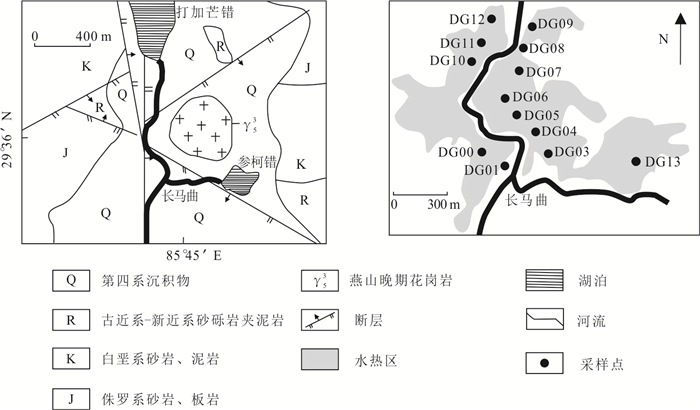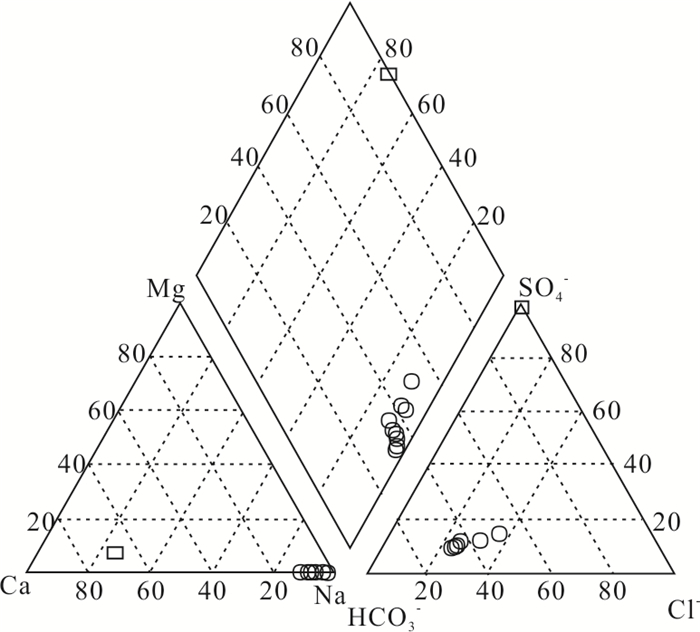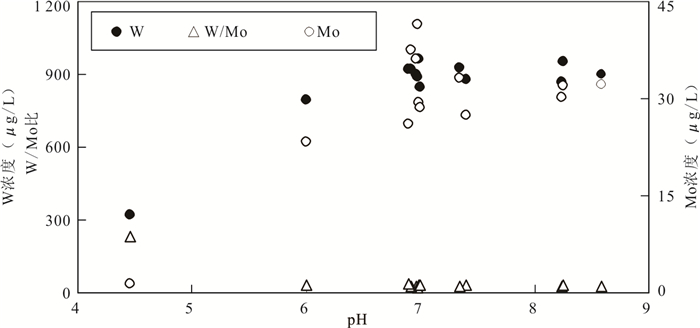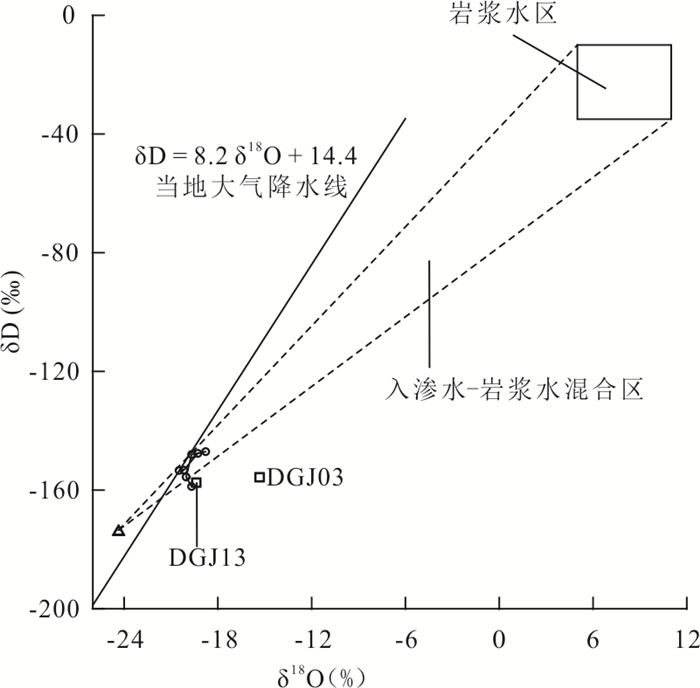Tungsten Anomaly of the High-Temperature Hot Springs in the Daggyai Hydrothermal Area, Tibet, China
-
摘要: 西藏搭格架水热区的热泉含异常高浓度的钨,其钨/钼比也远高于常见天然水.开展了搭格架典型热泉的地球化学研究,发现中性热泉的钨浓度显著高于偏酸性热泉:前者是深部母地热流体经绝热冷却、传导冷却等过程后排出地表而形成,其中的钨主要来自岩浆水的贡献;而后者为中性地热水和蒸汽加热型强酸性水的混合产物,贫钨蒸汽加热型水的稀释使其钨浓度不同程度降低.在地热水中,钨与典型保守组分氯相似,不易自液相沉淀或被热储介质吸附;但地热水含硫化物时,钼则极易以辉钼矿的形式沉淀,导致搭格架热泉的钨/钼比偏高.虽然搭格架地热水中存在硫化物,但钨在水中主要以钨酸盐的形式存在,少量硫代钨酸盐的形成对钨的水文地球化学过程影响不大.Abstract: Extremely high concentrations of tungsten was detected in the hot springs discharged from the Daggyai hydrothermal area, Tibet, and their tungsten to molybdenum ratios are much higher than common natural waters as well. A hydrogeochemical study of typical Daggyai hot springs was carried out, based on which it was found that the tungsten concentrations of the neutral springs are significantly higher than those of the acid springs. The neutral hot springs at Daggyai were formed via the adiabatic cooling or conductive cooling of the parent geothermal fluids ascending from the deep levels to the surface, and the tungsten in these waters is primarily from the contribution of magmatic fluids. In contrast, the slightly acid hot springs are basically a mixture of the steam-heated acid waters and neutral geothermal waters, and the dilution of tungsten-depleted steam-heated waters lowered the tungsten concentrations of these springs to various degrees. In geothermal systems, tungsten behaves generally like chloride, a typical conservative component, and is difficult to precipitate from geothermal water or to be adsorbed by reservoir rocks. However, molybdenum is prone to precipitate from sulfide-rich Daggyai geothermal waters as the form of molybdenite, resulting in the high tungsten to molybdenum ratios of the Daggyai hot springs. Moreover, although sulfide exists in the Daggyai geothermal waters, the major species of tungsten is tungstate instead of thiotungstates. The formation of trace thiotungstates has little effects on the tungsten-involved hydrogeochemical processes.
-
Key words:
- hot spring /
- tungsten /
- thiotungstates /
- hydrogeochemical /
- Daggyai /
- Tibet /
- hydrogeology
-
图 1 搭格架水热系统的区域大地构造背景
MBT. 主边界断层;ITS. 雅鲁藏布江缝合带;BNS. 班公错-怒江缝合带;JS. 龙木错-金沙江缝合带;据Guo et al.(2019b)修改
Fig. 1. Regional tectonic setting of the Daggyai hydrothermal system
图 2 搭格架水热区地质简图及采样位置
据郑绵平等(1995)修改
Fig. 2. Simplified geological map of the Daggyai hydrothermal area and sampling locations
图 7 搭格架热泉的δD-δ18O关系
岩浆水氢氧同位素组成引自Giggenbach(1992);大气降水线引自Tan et al.(2014);□. 酸性热泉;○. 中性热泉;△. 入渗水;引自Guo et al.(2010)
Fig. 7. δD-δ18O relations of the Daggyai hot springs
表 1 搭格架热泉样品的水文地球化学和同位素地球化学特征
Table 1. Hydrogeochemical and isotopic characteristics of the Daggyai hot springs
样品编号 T(℃) pH EC(µs/cm) EH(V) W(µg/L) Mo(µg/L) W/Mo 硫化物(mg/L) δD(‰ SMOW) δ18O(‰ SMOW) DGJ00 79.3 8.59 1 873 -0.389 899.9 32.20 28 0.15 -153 -20.5 DGJ01 79.5 8.24 1 910 -0.357 868.5 30.20 29 0.09 -153 -20.2 DGJ03 69.1 4.46 386 -0.060 323.1 1.41 230 0.04 -156 -15.3 DGJ04 80.1 7.40 1 912 -0.307 879.2 27.40 32 0.07 -148 -19.3 DGJ05 78.9 8.25 2 004 -0.358 950.1 32.00 30 0.13 -147 -18.8 DGJ06 74.1 6.96 1 916 -0.272 897.6 36.10 25 0.15 n.a. n.a. DGJ07 82.1 6.97 1 872 -0.278 890.4 41.50 21 0.11 -148 -19.7 DGJ08 75.5 6.92 1 994 -0.269 923.1 37.40 25 0.09 n.a. n.a. DGJ09 41.5 6.90 1 678 -0.212 919.9 26.10 35 0.20 n.a. n.a. DGJ10 81.9 7.35 1 914 -0.320 925.6 33.20 28 0.49 -156 -20.0 DGJ11 79.9 6.99 1 966 -0.287 961.2 29.30 33 0.26 n.a. n.a. DGJ12 77.8 7.00 1 805 -0.285 849.3 28.60 30 0.15 -159 -19.7 DGJ13 80.2 6.00 1 502 -0.203 795.7 33.30 24 0.12 -157 -19.4 注:n.a. 未分析;表中水化学数据据 Guo et al. (2019a) .表 2 水中钨的不同形态的化学热力学数据
Table 2. Chemical thermodynamic data of various tungsten species in water
钨的形态 化学结构式 化学反应式 log(K) 来源 钨酸盐 HnWO4n-2 (n=0, 1, 2) WO42-+H+=HWO4- 3.60 Smith and Martell(2004) WO42-+2H+=H2WO4 5.80 Smith and Martell(2004) 一硫代钨酸盐 WSO32- WO42-+H2S=WSO32-+H2O 3.08 Mohajerin et al.(2014) 二硫代钨酸盐 WS2O22- WSO32-+H2S=WS2O22-+H2O 3.22 Mohajerin et al.(2014) 三硫代钨酸盐 WS3O2- WS2O22-+H2S=WS3O2-+H2O 2.76 Mohajerin et al.(2014) 四硫代钨酸盐 WS42- WS3O2-+H2S=WS42-+H2O 2.36 Mohajerin et al.(2014) 注:n.a. 未分析;表中水化学数据据 Guo et al. (2019a) .表 3 搭格架热泉中钨酸盐和硫代钨酸盐的浓度(mol/L)
Table 3. Concentrations of tungstate and thiotungstate in the Daggyai hot springs (mol/L)
样品编号 钨酸盐 一硫代钨酸盐 二硫代钨酸盐 三硫代钨酸盐 四硫代钨酸盐 WO42- HWO4- H2WO4 WSO32- WS2O22- WS3O2- WS42- DGJ00 4.90×10-6 3.08×10-11 1.06×10-17 3.40×10-12 3.26×10-18 1.08×10-24 1.43×10-31 DGJ01 4.73×10-6 6.68×10-11 5.16×10-17 3.16×10-12 2.92×10-18 9.33×10-25 1.19×10-31 DGJ03 2.83×10-7 3.06×10-8 1.55×10-10 3.09×10-10 4.68×10-13 2.45×10-16 5.11×10-20 DGJ04 4.79×10-6 4.67×10-10 2.50×10-15 2.64×10-11 2.01×10-16 5.32×10-22 5.59×10-28 DGJ05 5.18×10-6 7.06×10-11 5.30×10-17 5.86×10-12 9.14×10-18 4.95×10-24 1.07×10-30 DGJ06 4.89×10-6 1.33×10-9 1.96×10-14 1.84×10-10 9.51×10-15 1.71×10-19 1.22×10-24 DGJ07 4.85×10-6 1.27×10-9 1.82×10-14 8.16×10-11 1.89×10-15 1.52×10-20 4.88×10-26 DGJ08 5.03×10-6 1.50×10-9 2.42×10-14 1.40×10-10 5.36×10-15 7.12×10-20 3.77×10-25 DGJ09 5.01×10-6 1.63×10-9 2.80×10-14 4.70×10-10 6.09×10-14 2.74×10-18 4.90×10-23 DGJ10 5.04×10-6 5.50×10-10 3.29×10-15 2.04×10-10 1.14×10-14 2.20×10-19 1.70×10-24 DGJ11 5.24×10-6 1.31×10-9 1.80×10-14 2.50×10-10 1.64×10-14 3.75×10-19 3.41×10-24 DGJ12 4.63×10-6 1.16×10-9 1.57×10-14 3.15×10-10 2.96×10-14 9.65×10-19 1.25×10-23 DGJ13 4.32×10-6 1.12×10-8 1.54×10-12 9.79×10-10 3.06×10-13 3.32×10-17 1.43×10-21 注:n.a. 未分析;表中水化学数据据 Guo et al. (2019a) .表 4 搭格架热泉样品相对于常见含钼矿物的饱和指数
Table 4. Saturation indices of the Daggyai hot springs with respect to common molybdenum-bearing minerals
样品编号 辉钼矿 硒钼矿 钼钙矿 钼铁矿 钼镁矿 钼镍矿 钼华 DGJ00 5.77 -26.04 -1.75 -29.99 -10.85 -10.40 -11.88 DGJ01 6.21 -24.62 -1.75 -28.67 -10.86 -9.80 -11.21 DGJ03 18.83 n.a. -3.24 -24.30 -12.16 -8.64 -5.09 DGJ04 9.41 -21.27 -1.67 -26.72 -10.78 -9.19 -9.57 DGJ05 6.79 n.a. -1.81 -28.45 -11.15 -10.01 -11.21 DGJ06 12.78 n.a. -1.74 -26.07 -10.89 -8.14 -8.57 DGJ07 11.09 6.88 -1.74 -25.32 -10.94 -8.24 -8.53 DGJ08 12.39 -19.48 -2.29 -26.91 -11.43 -8.31 -8.47 DGJ09 17.99 11.37 -1.91 -26.59 -11.14 -8.00 -8.57 DGJ10 11.31 n.a. -1.69 -26.63 -10.80 -8.87 -9.39 DGJ11 12.18 -19.84 -2.08 -26.69 -11.39 -8.61 -8.72 DGJ12 12.77 -19.85 -2.45 -28.50 -11.56 -8.91 -8.74 DGJ13 15.10 n.a. -2.36 -24.46 -11.54 -7.80 -6.82 注:n.a. 由于样品中硒未检出,未计算样品相对于硒钼矿的饱和指数. -
Arnórsson, S., Óskarsson, N., 2007. Molybdenum and Tungsten in Volcanic Rocks and in Surface and < 100℃ Ground Waters in Iceland. Geochimica et Cosmochimica Acta, 71(2): 284-304. https://doi.org/10.1016/j.gca.2006.09.030 Chen, X., Deng, X., Zhang, J., et al., 2018. Fluid Inclusions Constraints on the Origin of the Xiaobaishitou W-Mo Deposit in Hami, Xingjiang, NW China. Earth Science, 43 (9): 3086-3099 (in Chinese with English abstract). http://www.researchgate.net/publication/329031227_Fluid_Inclusions_Constraints_on_the_Origin_of_the_Xiaobaishitou_W-Mo_Deposit_in_Hami_Xinjiang_NW_China Farnham, I. M., Johannesson, K. H., Singh, A. K., et al., 2003. Factor Analytical Approaches for Evaluating Groundwater Trace Element Chemistry Data. Analytica Chimica Acta, 490(1/2): 123-138. https://doi.org/10.1016/s0003-2670(03)00350-7 Firdaus, M.L., Norisuye, K., Nakagawa, Y., et al., 2008. Dissolved and Labile Particulate Zr, Hf, Nb, Ta, Mo and W in the Western North Pacific Ocean. Journal of Oceanography, 64(2): 247-257. https://doi.org/10.1007/s10872-008-0019-z Giggenbach, W. F., 1992. Isotopic Shifts in Waters from Geothermal and Volcanic Systems along Convergent Plate Boundaries and their Origin. Earth and Planetary Science Letters, 113(4): 495-510. https://doi.org/10.1016/0012-821x(92)90127-h Guo, Q. H., Li, Y. M., Luo, L., 2019a. Tungsten from Typical Magmatic Hydrothermal Systems in China and its Environmental Transport. Science of the Total Environment, 657(2-3): 1523-1534. https://doi.org/10.1016/j.scitotenv.2018.12.146 Guo, Q. H., Planer-Friedrich, B., Liu, M. L., et al., 2019b. Magmatic Fluid Input Explaining the Geochemical Anomaly of very High Arsenic in some Southern Tibetan Geothermal Waters. Chemical Geology, 513(3): 32-43. https://doi.org/10.1016/j.chemgeo.2019.03.008 Guo, Q. H., Liu, M. L., Li, J. X., et al., 2014a. Acid Hot Springs Discharged from the Rehai Hydrothermal System of the Tengchong Volcanic Area (China): Formed Via Magmatic Fluid Absorption or Geothermal Steam Heating? Bulletin of Volcanology, 76(10): 1-12. https://doi.org/10.1007/s00445-014-0868-9 Guo, Q. H., Nordstrom, D.K., McCleskey, R.B., 2014b. Towards Understanding the Puzzling Lack of Acid Geothermal Springs in Tibet (China): Insight from a Comparison with Yellowstone (USA) and Some Active Volcanic Hydrothermal Systems. Journal of Volcanology and Geothermal Research, 288(Nb2): 94-104. https://doi.org/10.1016/j.jvolgeores.2014.10.005 Guo, Q. H., Planer-Friedrich, B., Liu, M. L., et al., 2017. Arsenic and Thioarsenic Species in the Hot Springs of the Rehai Magmatic Geothermal System, Tengchong Volcanic Region, China. Chemical Geology, 453(1): 12-20. https://doi.org/10.1016/j.chemgeo.2017.02.010 Guo, Q. H., Wang, Y. X., Liu, W., 2010. O, H, and Sr Isotope Evidences of Mixing Processes in Two Geothermal Fluid Reservoirs at Yangbajing, Tibet, China. Environmental Earth Sciences, 59(7): 1589-1597. https://doi.org/10.1007/s12665-009-0145-y Hall, G. E. M., Jefferson, C. W., Michel, F. A., 1988. Determination of W and Mo in Natural Spring Waters by ICP-AES (Inductively Coupled Plasma Atomic Emission Spectrometry) and ICP-MS (Inductively Coupled Plasma Mass Spectrometry): Application to South Nahanni River Area, N.W.T., Canada. Journal of Geochemical Exploration, 30(1/2/3): 63-84. https://doi.org/10.1016/0375-6742(88)90050-7 Johannesson, K.H., Lyons, W.B., Graham, E.Y., Welch, K.A., 2000. Oxyanion Concentrations in Eastern Sierra Nevada Rivers-3. Boron, Molybdenum, Vanadium, and Tungsten. Aquatic Geochemistry, 6(1): 19-46. doi: 10.1023/A:1009622219482 Kalinich, J. F., Emond, C. A., Dalton, T. K., et al., 2005. Embedded Weapons-Grade Tungsten Alloy Shrapnel Rapidly Induces Metastatic High-Grade Rhabdomyosarcomas in F344 Rats. Environmental Health Perspectives, 113(6): 729-734. https://doi.org/10.1289/ehp.7791 Kelly, A. D. R., Lemaire, M., Young, Y. K., et al., 2012. In Vivo Tungsten Exposure Alters B-Cell Development and Increases DNA Damage in Murine Bone Marrow. Toxicological Sciences, 131(2): 434-446. https://doi.org/10.1093/toxsci/kfs324 Kishida, K., Sohrin, Y., Okamura, K., et al., 2004. Tungsten Enriched in Submarine Hydrothermal Fluids. Earth and Planetary Science Letters, 222(3/4): 819-827. https://doi.org/10.1016/j.epsl.2004.03.034 Kletzin, A., Adams, M. W. W., 1996. Tungsten in Biological Systems. FEMS Microbiology Reviews, 18(1): 5-63. https://doi.org/10.1111/j.1574-6976.1996.tb00226.x Konhauser, K. O., Powell, M. A., Fyfe, W. S., et al., 1997. Trace Element Chemistry of Major Rivers in Orissa State, India. Environmental Geology, 29(1/2): 132-141. https://doi.org/10.1007/s002540050111 Koutsospyros, A., Braida, W., Christodoulatos, C., et al., 2006. A Review of Tungsten: From Environmental Obscurity to Scrutiny. Journal of Hazardous Materials, 136(1): 1-19. https://doi.org/10.1016/j.jhazmat.2005.11.007 Krauskopf, K.B., 1974. Tungsten. In: Wedepohl, H.K., ed., Handbook of Geochemistry, Vol. 5. Springer, New York. Marquet, P., Franç ois, B., Vignon, P., et al., 1996. A Soldier Who Had Seizures after Drinking Quarter of a Litre of Wine. The Lancet, 348(9034): 1070. https://doi.org/10.1016/s0140-6736(96)05459-1 Marquet, P., Franç ois, B., Lotfi, H., et al., 1997. Tungsten Determination in Biological Fluids, Hair and Nails by Plasma Emission Spectrometry in a Case of Severe Acute Intoxication in Man. Journal of Forensic Sciences, 42(3): 14162J. https://doi.org/10.1520/jfs14162j McCleskey, R. B., Nordstrom, D. K., Susong, D. D., et al., 2010. Source and Fate of Inorganic Solutes in the Gibbon River, Yellowstone National Park, Wyoming, USA. Ⅱ. Trace Element Chemistry. Journal of Volcanology and Geothermal Research, 196(3/4): 139-155. https://doi.org/10.1016/j.jvolgeores.2010.05.004 Mohajerin, T. J., Helz, G. R., White, C. D., et al., 2014. Tungsten Speciation in Sulfidic Waters: Determination of Thiotungstate Formation Constants and Modeling their Distribution in Natural Waters. Geochimica et Cosmochimica Acta, 144(53): 157-172. https://doi.org/10.1016/j.gca.2014.08.037 Sheppard, P. R., Ridenour, G., Speakman, R. J., et al., 2006. Elevated Tungsten and Cobalt in Airborne Particulates in Fallon, Nevada: Possible Implications for the Childhood Leukemia Cluster. Applied Geochemistry, 21(1): 152-165. https://doi.org/10.1016/j.apgeochem.2005.09.012 Sheppard, P. R., Speakman, R. J., Ridenour, G., et al., 2007. Temporal Variability of Tungsten and Cobalt in Fallon, Nevada. Environmental Health Perspectives, 115(5): 715-719. https://doi.org/10.1289/ehp.9451 Smith, G.R., 1994. Materials Flow of Tungsten in the United States. US Department of the Interior, Bureau of Mines, Information Circular, C9388, New York. Smith, R.M., Martell, A.E., 2004. NIST Standard Reference Database 46: NIST Critically Selected Stability Constants of Metal Complexes Database. US Department of Commerce Technology Administration, New York. Sohrin, Y., Isshiki, K., Kuwamoto, T., et al., 1987. Tungsten in North Pacific Waters. Marine Chemistry, 22(1): 95-103. https://doi.org/10.1016/0304-4203(87)90051-x Sohrin, Y., Matsui, M., Nakayama, E., 1999. Contrasting Behavior of Tungsten and Molybdenum in the Okinawa Trough, the East China Sea and the Yellow Sea. Geochimica et Cosmochimica Acta, 63(19/20): 3457-3466. https://doi.org/10.1016/s0016-7037(99)00273-2 Stefánsson, A., Arnórsson, S., 2005. The Geochemistry of As, Mo, Sb, and W in Natural Geothermal Waters, Iceland, Proceedings World Geothermal Congress, Antalaya, Turkey. Steinberg, K. K., Relling, M. V., Gallagher, M. L., et al., 2007. Genetic Studies of a Cluster of Acute Lymphoblastic Leukemia Cases in Churchill County, Nevada. Environmental Health Perspectives, 115(1): 158-164. https://doi.org/10.1289/ehp.9025 Tan, H. B., Zhang, Y. F., Zhang, W. J., et al., 2014. Understanding the Circulation of Geothermal Waters in the Tibetan Plateau Using Oxygen and Hydrogen Stable Isotopes. Applied Geochemistry, 51: 23-32. https://doi.org/10.1016/j.apgeochem.2014.09.006 Tyrrell, J., Galloway, T. S., Abo-Zaid, G., et al., 2013. High Urinary Tungsten Concentration is Associated with Stroke in the National Health and Nutrition Examination Survey 1999-2010. PLoS ONE, 8(11): e77546. https://doi.org/10.1371/journal.pone.0077546 Van der Sloot, H. A., Hoede, D., Wijkstra, J., et al., 1985. Anionic Species of V, As, Se, Mo, Sb, Te and W in the Scheldt and Rhine Estuaries and the Southern Bight (North Sea). Estuarine, Coastal and Shelf Science, 21(5): 633-651. https://doi.org/10.1016/0272-7714(85)90063-0 Witten, M. L., Sheppard, P. R., Witten, B. L., 2012. Tungsten Toxicity. Chemico-Biological Interactions, 196(3): 87-88. https://doi.org/10.1016/j.cbi.2011.12.002 Xu, P., Zheng, Y., Yang, Z., et al., 2019. Sources of Ore-Forming Fluids and Materials of Jiagangxueshan W-Mo Deposit. Earth Science, 44(6): 1974-1986 (in Chinese with English abstract). http://en.cnki.com.cn/Article_en/CJFDTotal-DQKX201906016.htm Yan, G.Q., Wang, X.X., Huang, Y., et al., 2020. Constraint of Pb Isotope on Ore-Forming Source Origin of Nuri Polymetallic Deposit, Tibet. Earth Science, 45(1): 31-42 (in Chinese with English abstract). Zhang, Z., Zhu, M., Liu, S., et al., 1982. Preliminary Study of Hydrogeochemistry of Thermal Waters in Tibet. Acta Scientiarum Naturalium Universitatis Pekinensis, 1(3): 88-96 (in Chinese with English abstract). Zheng, M., Wang, Q., Duo, J., et al., 1995. New Types of Hydrothermal Mineralization: Cesium Sinter Deposit in Tibet. Geology Press, Beijing (in Chinese). 陈叙安, 邓小华, 张静, 等, 2018. 新疆哈密小白石头钨钼矿床流体包裹体及矿床成因. 地球科学, 43(9): 3086-3099. doi: 10.3799/dqkx.2018.171 徐培言, 郑远川, 杨竹森, 等, 2019. 西藏甲岗雪山钨钼矿床成矿流体及成矿物质来源. 地球科学, 44(6): 1974-1986. doi: 10.3799/dqkx.2019.066 闫国强, 王欣欣, 黄勇, 等, 2020. Pb同位素对努日铜钼钨多金属矿床成矿物源的制约. 地球科学, 45(1): 31-42. doi: 10.3799/dqkx.2019.191 张知非, 朱梅湘, 刘时彬, 等, 1982. 西藏水热地球化学的初步研究. 北京大学学报(自然科学版), 18(3): 88-96. https://www.cnki.com.cn/Article/CJFDTOTAL-BJDZ198203009.htm 郑绵平, 王秋霞, 多吉, 等, 1995. 水热成矿新类型——西藏铯硅华矿床. 北京: 地质出版社, 1-114. -









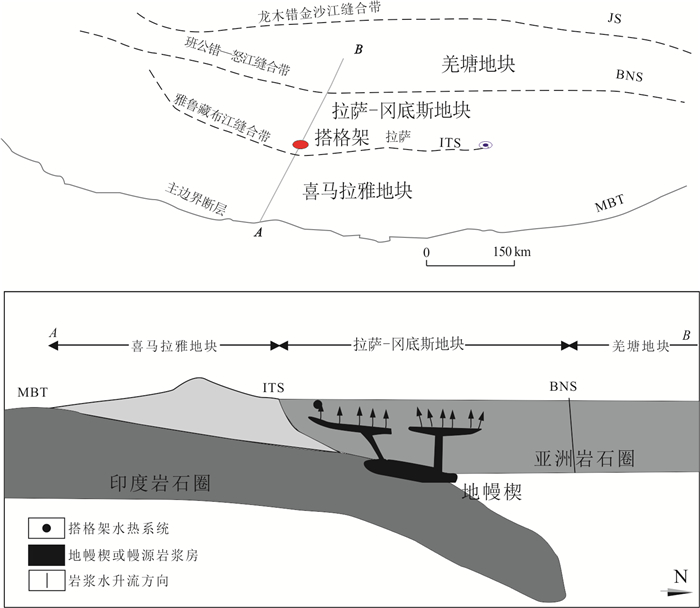
 下载:
下载:
